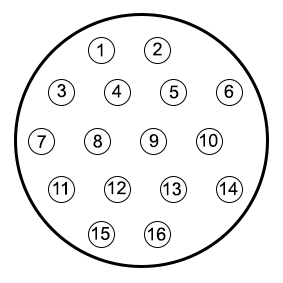Difference between revisions of "McPherson Monochromator"
| Line 15: | Line 15: | ||
To use the built-in motor there are two connectors to consider, one directly going to the stepper motor (Parker LV231-02-10)and one going to the limit switches. The connection on the back of the monochromator connecting the limit switches is shown below. The numbers in the image correspond with numbers on the connector itself. Pin 5 and 6 are connected to one another via a blue cable, this can be used to see if you connected the connector right side up. Pin 11 and 15 is the lower wavelength switch, the front of the monochromator. Pin 13 and 16 is the higher wavelength switch, the back of the monochromator. These switches are always passing through a signal and when pressed break connection. From pins 7, 8, and 9 we do not know exactly what their purpose is. They seem to be connected to some sort of sensor determining a region. | To use the built-in motor there are two connectors to consider, one directly going to the stepper motor (Parker LV231-02-10)and one going to the limit switches. The connection on the back of the monochromator connecting the limit switches is shown below. The numbers in the image correspond with numbers on the connector itself. Pin 5 and 6 are connected to one another via a blue cable, this can be used to see if you connected the connector right side up. Pin 11 and 15 is the lower wavelength switch, the front of the monochromator. Pin 13 and 16 is the higher wavelength switch, the back of the monochromator. These switches are always passing through a signal and when pressed break connection. From pins 7, 8, and 9 we do not know exactly what their purpose is. They seem to be connected to some sort of sensor determining a region. | ||
| − | + | {| style="margin: auto" | |
| + | |[[File:ConnectorBlank.png|frameless|caption]] | ||
| + | | | ||
| + | | | ||
* 1 - no connection | * 1 - no connection | ||
* 2 - No connection | * 2 - No connection | ||
| Line 32: | Line 35: | ||
* 15 - White/yellow | * 15 - White/yellow | ||
* 16 - Brown | * 16 - Brown | ||
| + | |} | ||
==Files== | ==Files== | ||
Revision as of 14:53, 3 February 2022
This page contains information about the McPherson Monochromator.
Basic information
We have in our setup the McPherson 302 .2 meter scanning monochromator. Where the wavelength can be selected using the setting dial on the device or using the built-in motor. To control this built-in motor we do not have the controller but we will use an Arduino to control the motor which gives us more control over changing wavelengths within our measurement run.
Wavelength
The limit switches define the movement limit of the motor without damaging the components:
Lower limit: 99723 Å below 0 Upper limit: Å (To be added)
The operational range of wavelength for measurement is:
nm - nm (To be added)
Motor controls
To use the built-in motor there are two connectors to consider, one directly going to the stepper motor (Parker LV231-02-10)and one going to the limit switches. The connection on the back of the monochromator connecting the limit switches is shown below. The numbers in the image correspond with numbers on the connector itself. Pin 5 and 6 are connected to one another via a blue cable, this can be used to see if you connected the connector right side up. Pin 11 and 15 is the lower wavelength switch, the front of the monochromator. Pin 13 and 16 is the higher wavelength switch, the back of the monochromator. These switches are always passing through a signal and when pressed break connection. From pins 7, 8, and 9 we do not know exactly what their purpose is. They seem to be connected to some sort of sensor determining a region.
